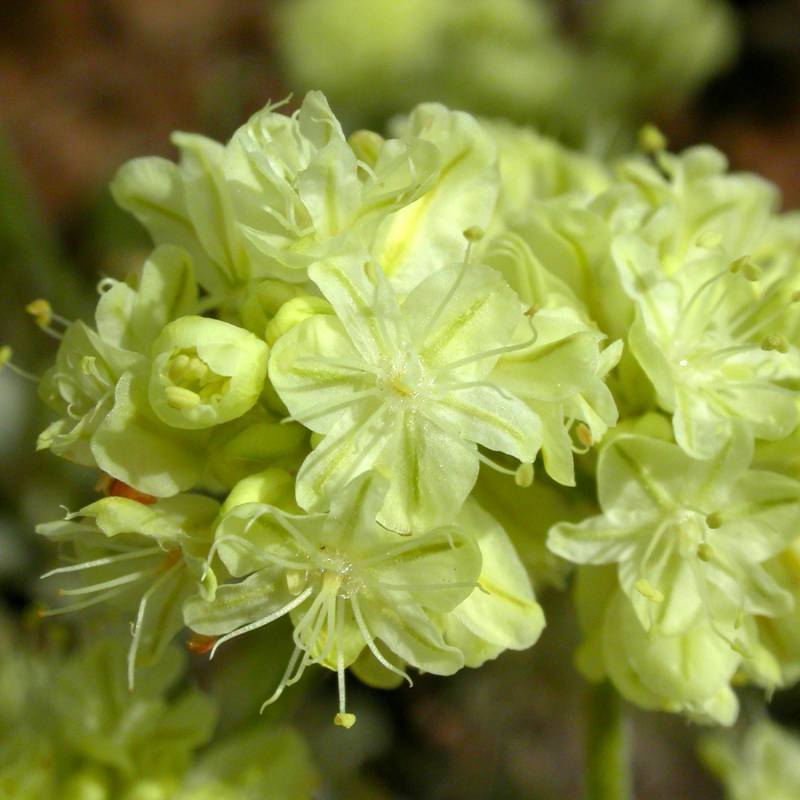|
strict buckwheat
|
snow buckwheat
|
| Perennial with woody stems up to 1 dm. long, the several flowering stems to 3 dm. tall, usually white-woolly throughout and more or less freely branched. |
Freely-branched perennial with a woody base, occasionally prostrate, but usually erect, the many branches forming a clump up to 4 dm. tall and wide. |
Mostly basal, the blades elliptic to ovate, 5-25 mm. long, usually white-woolly on the lower surface and less so on the top, on petioles as long to 4 times as along as the blades. |
Leaves tufted, mostly basal, 1.5-6 cm. long, the blade oblong-ovate to broadly lanceolate, about the same length as the petiole, densely gray-woolly on both sides. |
Flowering stems leafless, the inflorescence from open and freely branched with the involucres single at the branch tips to umbellate and the involucres somewhat clustered; with small, linear bracts at the forks of the branches; involucres narrowly cup-shaped, with 5 triangular, erect, short teeth; tepals white or cream to pinkish or yellow, 3-4 mm. long, divided nearly to the non-stipitate base, the segments oblong, the outer twice as broad as the inner. |
Flowering stems are several times di- or trichotomously branched, forming a large inflorescence that is gray-woolly throughout. Involucres 3-4 mm. long, conic, usually with 3 erect teeth, borne singly throughout the inflorescence and subtended by a pair of leafy bracts. Tepals 6, cream to pink, 3-4 mm. long, the outer segments oblong and twice as broad as the inner segments. |
|
3-angled achene |
|
|
|
|
| Eriogonum strictum plants with the branched inflorescence may be separated from the similar E. niveum by the bracts at the branch joints, which are small and thread-like in E. strictum and leaf-like in E. niveum. The E. strictum plants with umbellate and somewhat compressed flower clusters may be confused with E. ovalifolium when the tight, head-like flower clusters of the latter are in umbels instead of single. |
The leafy bracts below the flowers throughout the inflorescence separates E. niveum from the similar E. strictum, which has no leafy bracts. |
| May-July |
June-September |
| Sandy or rocky soils, sagebrush desert to ponderosa pine forests. |
Sagebrush desert, dry ponderosa pine forest openings, in deep or sandy soil. |
Occurring east of the Cascades crest in Washington; Washington to California, east to Montana, Idaho, and Nevada.
|
Occurring east of the Cascades crest in Washington; British Columbia to Oregon, east to Idaho.
|
| Native |
Native |
| Not of concern |
Not of concern |
E. baileyi, E. cernuum, E. codium, E. compositum, E. douglasii, E. elatum, E. flavum, E. heracleoides, E. maculatum, E. marifolium, E. microtheca, E. niveum, E. nudum, E. ovalifolium, E. pyrolifolium, E. sphaerocephalum, E. thymoides, E. umbellatum, E. vimineum |
E. baileyi, E. cernuum, E. codium, E. compositum, E. douglasii, E. elatum, E. flavum, E. heracleoides, E. maculatum, E. marifolium, E. microtheca, E. nudum, E. ovalifolium, E. pyrolifolium, E. sphaerocephalum, E. strictum, E. thymoides, E. umbellatum, E. vimineum |
|
|
| |



